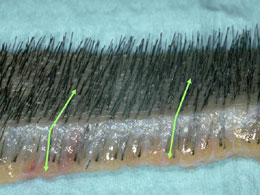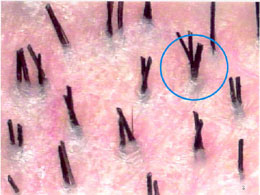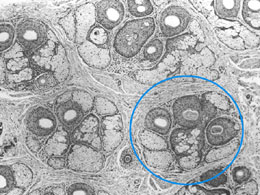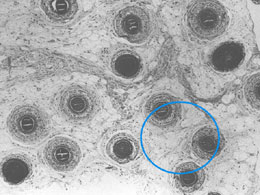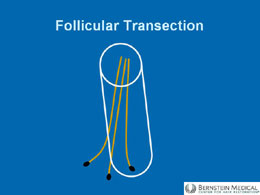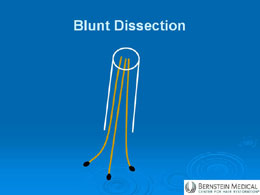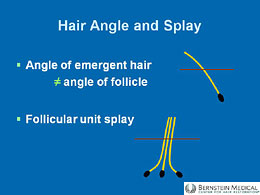
A major technical problem with harvesting hair directly from the scalp using a round cutting tool (a punch) is that it needs to precisely follow the direction of the hair follicles in order not to damage them. However, the angle of the hair changes as it emerges from the scalp. Therefore, the angle of the hair below the scalp can only be approximated by the operating surgeon, since he has no direct visibility under the skin. In addition, although the upper part of the follicular unit sits in a tight bundle, the lower portion splays outward. The following schematic illustrates these two issues:
These characteristics of follicular units can be seen in the following photos of human scalp:
Left: In this side view of a portion of the donor scalp, one can see how the angle of the hair follicle changes as it emerges from the surface.
Right: In this magnified view of the surface of the scalp, one can see the tight clustering of hair follicles in a follicular unit as the hair emerges from the scalp.
Left: In a view slightly below the surface of the scalp, one can still see the follicular unit as a tight bundle.
Right: As one goes deeper in the skin, the lower part of the follicle splays outward, so that the portion of the bulbs in the fat becomes essentially random.
Because of the angle change and splay, it is easy for a sharp punch to transect (cut) follicles during FUE. Below left, we see the problem of using a purely cutting instrument to remove the entire follicle. Below right, we see the advantage of using an instrument to separate the upper portion of the follicular unit from the surrounding tissue and then to “extract” the lower part without any additional cutting.
Left: Because of this splay a cutting instrument tends to shear off the ends of the bulbs as it penetrates the skin. This problem will be magnified if the cutting instrument is not inserted perfectly parallel with the follicles under the skin. As discussed, alignment is difficult because of the lack of visibility below the surface of the skin and the change in angle of the hair below the skin with respect to the surface.
Right: The principle behind Follicular Unit Extraction (FUE) is that, in order to avoid this injury, follicular units would not be totally excised (cut) from the scalp, but rather “extracted” or pulled out of the scalp, so that the lower part of the follicles would not be cut off. Figure B (above right) shows the instrument going partially down the follicular unit. Once the upper part of the unit is separated from the surrounding tissue, the entire follicular unit is then “extracted” (pulled out) of the skin.
- More about Follicular Unit Extraction
- Robotic FUE
- Robotic FUE FAQ
- Before & After Photos
- Physician Consult
In order to be effective, the cutting vs. blunt dissection properties of the punch must be exquisitely balanced and this had been the subject of much of the research (and progress) in FUE since we published our original paper on the subject in 2002. You can read that paper, called “Follicular Unit Extraction: Minimally Invasive Surgery for Hair Transplantation,” in the Bernstein’s Publications section or download it as a pdf.
Regardless of the precision of the blunt dissection instrument, the nature of “extraction” can cause the lower portions of the follicles to be pulled away from the surrounding tissue in the removal process and this can leave the lower part of the follicle “naked” risking injury and poor growth. This is still one of the major challenges to FUE researchers and a significant drawback to the procedure as it exists today.


